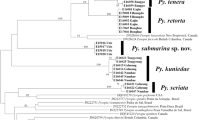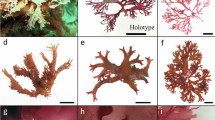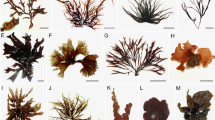Abstract
The funoran-producing red macroalga, Gloiopeltis, is known for its commercial uses. Since the economic value of Gloiopeltis is species-dependent, accurate species identification using molecular analysis such as DNA barcoding is important to obtain species-level identification and reveals the hitherto undiscovered biodiversity in Gloiopeltis. In this study, we investigated Gloiopeltis complanata specimens from various locations across Japan and Korea to confirm their relationships with specimens from the type locality in Japan. We employed a combination of molecular analyses using mitochondrial COI-5P as DNA barcoding and plastid rbcL markers, as well as detailed morphological examination of reproductive structures. Genetic analysis revealed the presence of two deeply divergent clades with nucleotide difference of 16.8–17.5% in COI-5P and 6.3–6.8% in rbcL, respectively. The difference in the position of reproductive structure in thallus further supported the subdivision of the Japanese and Korean specimens. As a result, we describe a new species, Gloiopeltis frutex sp. nov., based on the Korean specimens characterized by caespitose and subcylindrical to compressed thallus, slightly flexuous siphonous axis, cruciately divided tetrasporangia scattered over thallus, and slightly swollen cystocarps on proliferations. The results also suggest the necessity of further studies aimed at examining full spectrum of genetic diversity manifested in species of the family Endocladiaceae in detail.




Similar content being viewed by others
References
Abbott IA, Hollenberg GJ (1976) Marine algae of California. Stanford University Press, Stanford, pp [i]–xii, 1–827, 701 figs
Agardh JG (1842) Algae maris Mediterranei et Adriatici, observationes in diagnosin specierum et dispositionem generum. Paris. pp. [i]-x, 1–164
Baker RJ, Bradly RD (2006) Speciation in mammals and the genetic species concept. Am J Soc Mammalosists 87:643–662
Calderon MS, Boo SM (2014) A new species of phyllophoracean red algae (Gigartinales, Rhodophyta) from Korea: Stenogramma guleopensis sp. nov. Bot Mar 57:343–349
Cheang CC, Chu KH, Fujita D, Yoshida G, Hiraoka M, Critchley A, Choi HG, Duan D, Serisawa Y, Ang PO (2010) Low genetic variability of Sargassum muticum (Phaeophyceae) revealed by a global analysis of native and introduced populations. J Phycol 46:1063–1074
Chiang YM (1969) Observations on the reproductive organs of Gloiopeltis tenax (Turner) J. Agardh (Cryptonemiales, Endocladiaceae). Phycologia 8:193–197
Fan KC, Fan YP (1964) Studies on the reproductive organs of red algae. IV. Gloiopeltis furcata (Post. et Rupr.) J. Ag. Acta Bot Sin 12:274–276
Fang Z, Jeong SY, Jung HA, Choi JS, Min BS, Woo MH (2010) Anticholinesterase and antioxidant constituents from Gloiopeltis furcata. Chem Pharm Bull 58:442–451
Gavio B, Fredericq S (2002) Grateloupia turuturu (Halymeniaceae, Rhodophyta) is the correct name of the non-native species in the Atlantic known as Grateloupia doryphora. Eur J Phycol 37:349–360
Guiry MD, Guiry GM (2017) AlgaeBase. World-wide electronic publication. Galway, National University of Ireland. http://www.algaebase.org. Searched on 30 March 2017
Hall TA (1999) BioEdit: a user-friendly biological sequence alignment editor and analysis program for Windows 95/98/NT. Nucl Acids Symp Ser 41:95–98
Harvey WH (1860) Characters of new algae, chiefly from Japan and adjacent regions, collected by Charles Wright in the North Pacific Exploring Expedition under Captain James Rodgers. Proc Am Acad Arts Sci 4:327–335
Hirase S, Araki C, Ito T (1956) Constituents of the mucilage of Gloiopeltis furcata. Bull Chem Soc Jpn 29:985–987
Kamiya M (2004) Speciation and biogeography of the Caloglossa leprieurii complex (Delesseriaceae, Rhodophyta). J Plant Res 117:421–428
Kamiya M, West JA, King RJ, Zuccarello GC, Tanaka J, Hara Y (1998) Evolutionary divergence in the red algae Caloglossa leprieurii and C. apomeiotica. J Phycol 34:361–370
Kim MS, Kim SY, Nelson W (2010a) Symphyocladia lithophila sp. nov. (Rhodomelaceae, Ceramiales), a new Korean red algal species based on morphology and rbcL sequences. Bot Mar 53:233–241
Kim MS, Yang MY, Cho GY (2010b) Applying DNA barcoding to Korean Gracilariaceae (Rhodophyta). Cryptogam Algol 31:387–401
Kim KM, Hoarau GG, Boo SM (2012) Genetic structure and distribution of Gelidium elegans (Gelidiales, Rhodophyta) in Korea based on mitochondrial cox1 sequence data. Aquatic Bot 98:27–33
Kim SY, Han EG, Kim MS, Park JK, Boo SM (2013) Grateloupia jejuensis (Halymeniales, Rhodophyta): a new species previously confused with G. elata and G. cornea in Korea. Algae 28:233–240
Koh YH, Cho GY, Kim MS (2013) Species delimitation of the genus Champia (Rhodymeniales, Rhodophyta) from Korea using DNA barcoding. J Ecol Environ 36:449–463
Kumar S, Stecher G, Tamura K (2016) MEGA7: molecular evolutionary genetics analysis version 7.0 for bigger datasets. Mol Biol Evol 33:1870–1874
Kylin H (1930) Über die Entwicklungsgeschichte der Florideen. Acta Universitatis Lundensis 26:1–104
Kylin H (1956) Die Gattungen der Rhodophyceen. C.W.K. Gleerups, Lund. pp. i-xv, 1–673, 458 figs
Lee HW, Kim MS (2014) Cryptic species diversity of the red algal genus Callophyllis (Kallymeniaceae, Gigartinales) from Korea. J Ecol Environ 37:395–410
Lin SM, Hommersand MH, Fredericq S, De Clerck O (2009) Characterization of Martensia (Delesseriaceae, Rhodophyta) based on a morphological and molecular study of the type species, M. elegans, and M. natalensis sp. nov. from South Africa. J Phycol 45:678–691
Oh BG, Lee HB (1996) Morphology of three species of Gloiopeltis (Endocladiaceae, Rhodophyta) in Korea. Kor J Phycol 11:81–90
Okamura K (1902) Nippon Sorui-meii [Book listing Japanese Algae]. Tokyo pp i-vi, 1–276
Okamura K (1936) Nippon kaisô shi [Descriptions of Japanese algae]. Tokyo. pp. [4], [1]-964, [1]-11, frontispiece portrait, 1–427 figs
Payo DA, Leliaert F, Verbruggen H, D'hondt S, Calumpong HP, De Clerck O (2013) Extensive cryptic species diversity and fine-scale endemism in the marine red alga Portieria in the Philippines. Proc Roy Soc Lond B 280:20122660
Ren DL, Wang JZ, Noda H, Amano H, Ogawa S (1995) The effects of an algal polysaccharide from Gloiopeltis tenax on transplantable tumors and immune activities in mice. Planta Med 61:120–125
Ronquist F, Teslenko M, van der Mark P, Ayres D, Darling A, Hohna S, Larget B, Liu L, Suchard MA, Huelsenbeck JP (2012) MrBayes 3.2: efficient Bayesian phylogenetic inference and model choice across a large model space. Syst Biol 61:539–542
Sánchez N, Freshwater DW, Rodriguez-Prieto C (2010) Vegetative, reproductive and molecular characterization of Gloiocladia microspora (Faucheaceae, Rhodophyta). Eur J Phycol 45:63–78
Saunders GW (2005) Applying DNA barcoding to red macroalgae: a preliminary appraisal holds promise for future applications. Phil Trans Roy Soc B 360:1879–1888
Saunders GW (2008) A DNA barcode examination of the red algal family Dumontiaceae in Canadian waters reveals substantial cryptic diversity. 1. The foliolse Dilsea-Neodilsea complex and Weeksia. Botany 86:773–789
Saunders GW, McDevit DC (2012) Acquiring DNA sequence data from dried archival red algae (Florideophyceae) for the purpose of applying available names to contemporary genetic species: a critical assessment. Botany 90:191–203
Saunders GW, Millar KR (2014) A DNA barcode survey of the red algal genus Mazzaella in British Columbia reveals overlooked diversity and new distributional records: descriptions of M. dewreedei sp. nov. and M. macrocarpa sp. nov. Botany 92:223–231
Souza BW, Cerqueira MA, Martins JT, Quintas MA, Ferreira AC, Teixeira JA, Vicente AA (2011) Antioxidant potential of two red seaweeds from the Brazilian coasts. J Agric Food Chem 59:5589–5597
Stamatakis A (2006) RAxML-VI-HPC: maximum likelihood-based phylogenetic analyses with thousands of taxa and mixed models. Bioinformatics 22:2688–2690
Suringar WFR (1867) Algarum iaponicarum Musei Botanici L.B. index praecursorius. Annales Musei Botanici Lugduno-Batavi 3:256–259
Suringar WFR (1870) Algae japonicae Musei botanici lugduno-batavi. Harlemi [Harlem]: Typis Heredum Loosjes. pp. [1]-39, expl. pl., pls I-XXIV
Takano R, Hayashi K, Hara S, Hirase S (1995) Funoran from the red seaweed, Gloiopeltis complanata: polysaccharides with sulphated agarose structure and their precursor structure. Carbohydr Polym 27:305–311
Tang Y, Liu H, Yu Y, Li X (2016) Early life stage development of Gloiopeltis furcata (Gigartinales, Endocladiaceae) from northern China. J Biotech Res 7:49–56
Tuvikene R, Robal M, Fujita D, Saluri K, Truus K, Tashiro Y et al (2015) Funorans from Gloiopeltis species. Part I. Extraction and structural characteristics. Food Hydrocoll 43:481–4924
Uwai S, Kogame K, Yoshida G, Kawai H, Ajisaka T (2009) Geographical genetic structure and phylogeography of the Sargassum horneri/filicinum complex in Japan, based on the mitochondrial cox3 haplotype. Mar Biol 156:901–911
Wittmann W (1965) Aceto-iron-haematoxylin-chloral hydrate for chromosome staining. Biotech Histochem 40:161–164
Yamada Y (1932) Notes on some Japanese algae, III. J Faculty Sci, Hokkaido Imperial University 1:109–123
Yang MY, Kim MS (2015) Taxonomy of Grateloupia (Halymeniales, Rhodophyta) by DNA barcode marker analysis and a description of Pachymeniopsis volvita sp. nov. J Appl Phycol 27:1373–1384
Yang MY, Kim MS (2016) Molecular phylogeny of the genus Chondracanthus (Rhodophyta), focusing on the resurrection of C. okamurae and the description of C. cincinnus sp. nov. Ocean Sci J 51:517–529
Yang MY, Macaya EC, Kim MS (2015) Molecular evidence for verifying the distribution of Chondracanthus chamissoi and C. teedei (Gigartinaceae, Rhodophyta). Bot Mar 58:103–113
Zheng J, Chen Y, Yao F, Chen W, Shi G (2012) Chemical composition and antioxidant/antimicrobial activities in supercritical carbon dioxide fluid extract of Gloiopeltis tenax. Mar Drugs 10:2634–2647
Zuccarello GC, West JA, King RJ (1999) Evolutionary divergence in the Bostrychia moritziana/B. radicans complex (Rhodomelaceae, Rhodophyta): molecular and hybridisation data. Phycologia 38:234–244
Acknowledgements
We thank Dr. Kikuchi and Dr. Wada for helping us during our collection trip to Japan and members of the Molecular Phylogeny of Marine Algae Laboratory at Jeju National University.
Funding
This work was supported by the grant from the National Institute of Biological Resources (NIBR) funded by the Ministry of Environment (MOE) (NIBR201501209 for collecting samples) and the National research Foundation of Korea (NRF) grant funded by the Ministry of Science, ICT & Future Planning (2017R1A2B4009420) of the Republic of Korea.
Author information
Authors and Affiliations
Corresponding author
Rights and permissions
About this article
Cite this article
Yang, M.Y., Kim, M.S. DNA barcoding of the funoran-producing red algal genus Gloiopeltis (Gigartinales) and description of a new species, Gloiopeltis frutex sp. nov.. J Appl Phycol 30, 1381–1392 (2018). https://doi.org/10.1007/s10811-017-1330-0
Received:
Revised:
Accepted:
Published:
Issue Date:
DOI: https://doi.org/10.1007/s10811-017-1330-0




